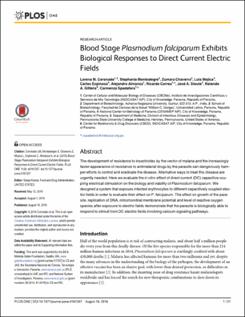| dc.contributor.author | Lax, Neil C. | |
| dc.contributor.author | Ahmed, Kh Tanvir | |
| dc.contributor.author | Ignatz, Christopher M. | |
| dc.contributor.author | Spadafora, Carmenza | |
| dc.contributor.author | Kolber, Benedict J. | |
| dc.contributor.author | Tidgewell, Kevin J. | |
| dc.date.accessioned | 2020-06-24T18:58:48Z | |
| dc.date.available | 2020-06-24T18:58:48Z | |
| dc.date.issued | 2016-11-01 | |
| dc.identifier.other | 10.1080/13880209.2016.1181659 | |
| dc.identifier.uri | http://repositorio-indicasat.org.pa/handle/123456789/109 | |
| dc.description | Marine cyanobacteria offer a robust resource for natural products drug discovery due to the secondary metabolites they produce. Objective—To identify novel cyanobacterial compounds that exhibit CNS psychoactive effects. Materials and methods—Cyanobacteria were collected from Las Perlas Archipelago, Panama and subjected to dichloromethane/methanol extraction and fractionation by column chromatography before being screened for affinity against a panel of CNS targets. A 50:50 ethyl acetate:methanol fraction of one cyanobacterial extract (2064H) was subjected to HPLC and the major peak was isolated (2064H3). At a dose of 20 μg per animal, 2064H and 2064H3 were tested in mice using behavioral assays that included the forced swim, open field, and formalin tests. Results—2064H was shown to bind to the serotonin 2C (5-HT2C) receptor, a known target for depression and pain treatment. 2064H showed 59.6% inhibition of binding of [3H]-mesulergine with an IC50 of 179 ng/mL and did not show inhibition of binding greater than 45% with any other receptors tested. Both 2064H and 2064H3 decreased immobility time in the first min of the tail suspension test. 2064H increased time, distance and number of entries in the center region in the first half of the open field test. 2064H increased overall nocifensive behaviors in the formalin test. Discussion and Conclusion—Overall, manipulating the 5-HT2C receptor with these receptorspecific ligands derived from cyanobacteria altered pain, depression and anxiety-like behaviors, illustrating the importance of this receptor in affective behaviors. These results demonstrate the potential of cyanobacteria as a source for CNS active compounds | en_US |
| dc.description.abstract | Marine cyanobacteria offer a robust resource for natural products drug discovery due to the secondary metabolites they produce. Objective—To identify novel cyanobacterial compounds that exhibit CNS psychoactive effects. Materials and methods—Cyanobacteria were collected from Las Perlas Archipelago, Panama and subjected to dichloromethane/methanol extraction and fractionation by column chromatography before being screened for affinity against a panel of CNS targets. A 50:50 ethyl acetate:methanol fraction of one cyanobacterial extract (2064H) was subjected to HPLC and the major peak was isolated (2064H3). At a dose of 20 μg per animal, 2064H and 2064H3 were tested in mice using behavioral assays that included the forced swim, open field, and formalin tests. Results—2064H was shown to bind to the serotonin 2C (5-HT2C) receptor, a known target for depression and pain treatment. 2064H showed 59.6% inhibition of binding of [3H]-mesulergine with an IC50 of 179 ng/mL and did not show inhibition of binding greater than 45% with any other receptors tested. Both 2064H and 2064H3 decreased immobility time in the first min of the tail suspension test. 2064H increased time, distance and number of entries in the center region in the first half of the open field test. 2064H increased overall nocifensive behaviors in the formalin test. Discussion and Conclusion—Overall, manipulating the 5-HT2C receptor with these receptorspecific ligands derived from cyanobacteria altered pain, depression and anxiety-like behaviors, illustrating the importance of this receptor in affective behaviors. These results demonstrate the potential of cyanobacteria as a source for CNS active compounds | en_US |
| dc.format | application/pdf | |
| dc.language.iso | eng | en_US |
| dc.rights | Info:eu-repo/semantics/openAccess | |
| dc.rights | https://creativecommons.org/licenses/by/4.0/ | |
| dc.subject | harmacognosy | en_US |
| dc.subject | depression | en_US |
| dc.subject | anxiety | en_US |
| dc.subject | pain | en_US |
| dc.subject | GPCR | en_US |
| dc.title | Marine cyanobacteria-derived serotonin receptor 2C active fraction induces psychoactive behavioral effects in mice | en_US |
| dc.type | info:eu-repo/semantics/article | en_US |
| dc.type | Info:eu-repo/semantics/publishedversion | |

